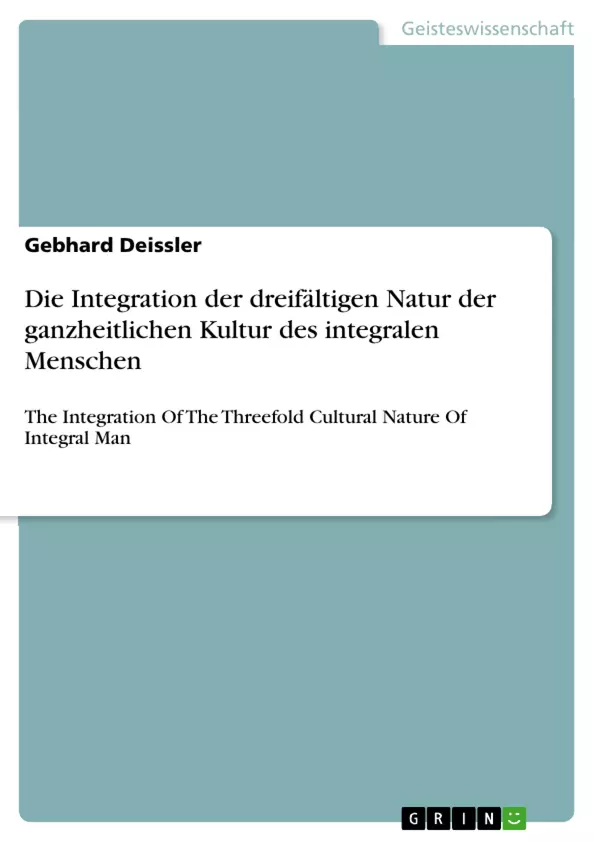Diese Erörterung thematisiert die persönliche kulturelle Integration, die integrativ in der Außenwelt wirkt. Die objektive instrumentelle interkulturelle Managementkompetenz und die subjektive zusammen verkörpern eine innovative Form ganzheitlichen interkulturellen Managements, da kulturelles Selbst- und Fremdmanagement interdependente Kulturmanagementdynamiken sind.
Inhaltsverzeichnis
- Teil/Part 1
- DIE KULTURELLE ARCHITEKTUR DES MENSCHEN
- Die biologische, die psychologische und die geistige Natur ganzheitlicher menschlicher Kultur
- Summum Unum - The Diversity of Life
- DIE KULTURELLE ARCHITEKTUR DES MENSCHEN
- Teil/Part 2
- THE DIVINE METAPHOR OF CREATION. A BENCHMARK FOR INTERCULURAL MANAGEMENT
- Cross-Cultural Observations
- The Enigma of the Cross
- The Root of Civilisation and the Tree of Life
- The Application of the Metaphor of Metaphors to the World's Cultures and their Integration
- Conquest and Ownership of and Leadership from the Innermost Center
- The Quantum-Cultural Motive in Creation
- Third Millennium Axiology
- CROSS-Cultural Management
- Cosmic Love
- The Civilisation of Love
- THE DIVINE METAPHOR OF CREATION. A BENCHMARK FOR INTERCULURAL MANAGEMENT
- Teil/Part 3
- A SYNOPSIS OF INTER-CULTURAL INTEGRATION INSTRUMENTS
- 31 Skills, formulas and techniques
- Bibliography
- A SYNOPSIS OF INTER-CULTURAL INTEGRATION INSTRUMENTS
Zielsetzung und Themenschwerpunkte
Das Buch "Die Integration der Dreifältigen Natur der Kultur des Integralen Menschen" befasst sich mit der Integration verschiedener Kulturen und der Entwicklung einer ganzheitlichen, integralen Kultur. Es analysiert die kulturelle Architektur des Menschen, die aus biologischen, psychologischen und geistigen Dimensionen besteht, und erforscht die Bedeutung der Metapher der Schöpfung für das interkulturelle Management.
- Die kulturelle Architektur des Menschen
- Die Metapher der Schöpfung als Grundlage für interkulturelles Management
- Die Integration verschiedener Kulturen
- Die Entwicklung einer integralen Kultur
- Die Bedeutung von Liebe und Mitgefühl in der globalen Gesellschaft
Zusammenfassung der Kapitel
Der erste Teil des Buches befasst sich mit der kulturellen Architektur des Menschen. Er analysiert die biologische, die psychologische und die geistige Natur des Menschen und zeigt, wie diese drei Dimensionen zusammenwirken, um eine ganzheitliche Kultur zu schaffen. Der zweite Teil des Buches untersucht die Metapher der Schöpfung als Grundlage für interkulturelles Management. Er analysiert die verschiedenen Kulturen der Welt und zeigt, wie die Metapher der Schöpfung als ein gemeinsamer Nenner für alle Kulturen dienen kann. Der dritte Teil des Buches bietet eine Zusammenfassung von Instrumenten und Techniken für die interkulturelle Integration.
Schlüsselwörter
Die Schlüsselwörter und Schwerpunktthemen des Textes umfassen die Integration, die Kultur, den integralen Menschen, die Metapher der Schöpfung, das interkulturelle Management, die Diversität, die Liebe, die Zivilisation und die Globalisierung. Der Text untersucht die kulturelle Architektur des Menschen, die Bedeutung der Metapher der Schöpfung für das interkulturelle Management und die Entwicklung einer integralen Kultur, die auf Liebe und Mitgefühl basiert.
- Citation du texte
- D.E.A./UNIV. PARIS I Gebhard Deissler (Auteur), 2012, Die Integration der dreifältigen Natur der ganzheitlichen Kultur des integralen Menschen, Munich, GRIN Verlag, https://www.grin.com/document/184559



